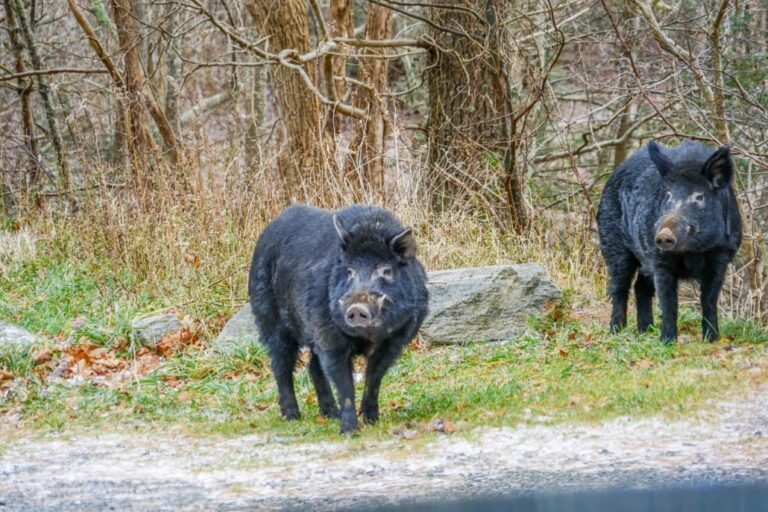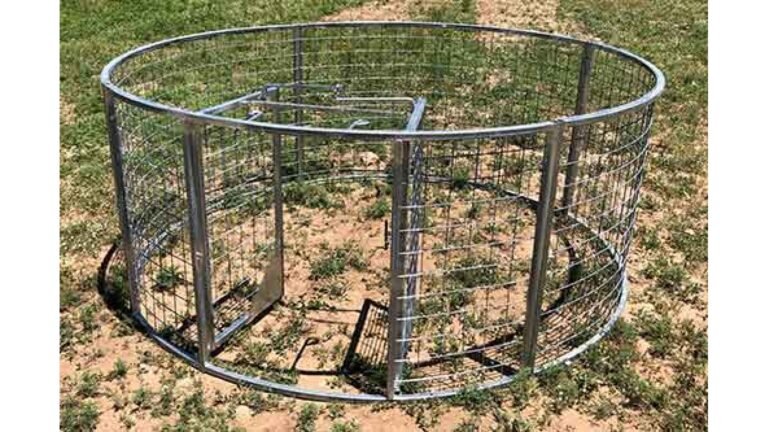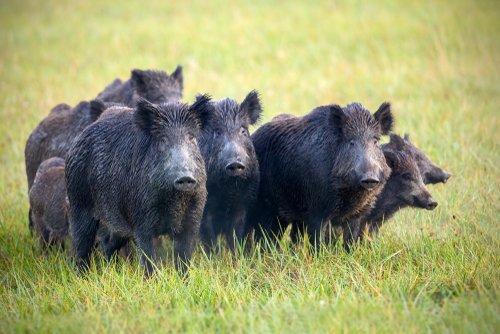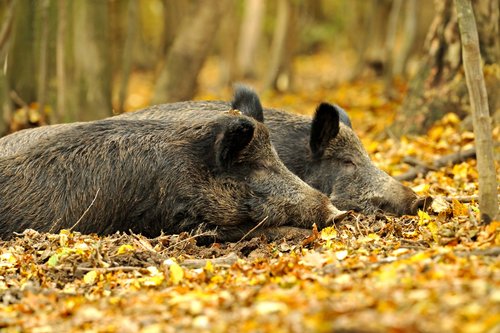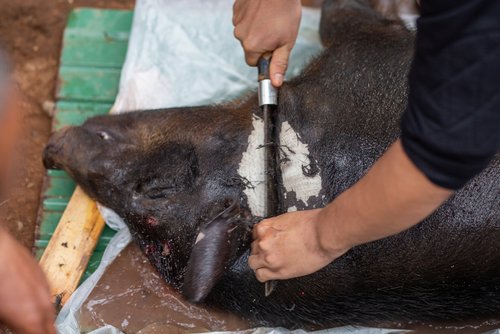Reading the Wild: Understanding Hog Signs for Successful Hunts
Wild hogs, also known as feral pigs or boars, have long been a fascinating subject for nature enthusiasts and hunters alike (because bacon is our favorite food). These highly adaptable creatures leave behind many tracks and signs that can tell us much about their presence and behavior in an area. Tracking wild hogs is an exciting pursuit and a valuable skill for those interested in understanding these elusive creatures on a deeper level. Let’s take a deeper dive into hog tracks and signs.
One must understand the art of reading the landscape when tracking wild hogs. Hogs follow specific trails and routes through their territory, leaving clear evidence of their travels.
By studying the terrain, such as thickets, creek beds, and wallows (mud holes), it becomes easier to predict where these cunning animals might be found. Identifying hog trails can give valuable insights into their feeding patterns and preferred habitats.
In addition to trails, hog markings are another crucial aspect of tracking these creatures. Hogs possess specialized glands that secrete scent markers on objects, such as tree trunks or rubbing posts.
These markings serve several purposes: communicating dominance among individuals, establishing territories, or attracting potential mates during the breeding season. By recognizing these distinct hog markings along your tracking path, you can gain insight into the social dynamics of these fascinating creatures.
Now, let’s delve into the nitty-gritty details: hog tracks themselves. When identifying hog tracks in mud or soft soil, there are certain characteristics to look out for.
Hog tracks generally appear round or oval-shaped with prominent toes that vary in size depending on the age and size of the animal. The front footprints tend to be larger than the hind ones due to hogs’ robust build.
Hog tracks often feature distinct dewclaw impressions located slightly higher up on each footprint’s rear edge. This distinguishing feature helps differentiate them from other animals’ tracks, like deer or coyotes. By carefully examining these footprints, one can determine the direction of travel, estimate the size of the hog, and even gauge how fresh or old the tracks are.
These clues are vital for successful tracking and understanding hog behavior in a given area. So, if you’re ready to embark on an adventure into the world of wild hogs, get your tracking skills honed.
With a keen eye for hog trails, an understanding of hog markings, and the ability to identify hog tracks accurately, you’ll be well-equipped to navigate their secretive world. The following sections will explore each aspect in more detail and provide expert tips for mastering this captivating pursuit.
The Art of Tracking Wild Hogs
Tracking wild hogs is both an art and a science. It requires keen observation skills, knowledge of hog behavior, and a deep understanding of the signs they leave behind. The first step in mastering the art of tracking wild hogs is identifying hog trails.
The repeated passage of hogs creates these trails as they move through their territory in search of food, water, or shelter. Look for areas with trampled vegetation and broken branches to identify hog trails.
Hogs follow the same paths repeatedly so that you may notice well-defined routes through brushy areas or along creek beds. These trails can sometimes be surprisingly subtle, blending seamlessly with their surroundings.
However, with practice and close attention to detail, you can start to distinguish hog trails from those made by other animals. Once you’ve identified a potential hog trail, it’s time to study the markings left behind by these elusive creatures.
Hog markings can include scratch marks on tree trunks or rocks that indicate where hogs have rubbed against them to relieve itching or mark their territory. You might also come across patches of mud where hogs have wallowed to cool down or rid themselves of parasites.
Another telltale sign is hair caught on fences or vegetation along the trail. Hogs have coarse bristles that can easily get snagged on objects as they pass through narrow openings or dense undergrowth.
By paying attention to these subtle details along the trail, you’ll gain valuable insights into the presence and habits of wild hogs in your area. Tracking wild hogs is about following physical signs and understanding their behavior patterns.
Hogs are intelligent animals that adapt quickly to changes in their environment. They often use dense cover for protection during daylight hours and venture out under cover of darkness to feed in open fields or root for food in wooded areas.
By studying their behavior patterns and combining this knowledge with the physical signs you uncover along the trail, you can create a more comprehensive picture of the habits and movement patterns of wild hogs in your area. This information will prove invaluable for effectively tracking and managing hog populations.
Reading the Landscape: Hog Trails and Routes
When tracking wild hogs, one of the essential skills to develop is the ability to read the landscape and identify hog trails and routes. These clues left behind by these fascinating creatures can provide valuable insights into their movement patterns and behavior.
By carefully studying the environment, one can unravel the mysteries of their dynamic world. Identifying hog trails can be a thrilling task for any nature enthusiast.
One key aspect to look for is disturbed vegetation or ground cover along a linear path. Hogs habitually push aside foliage as they navigate through dense brush, leaving a clear passage in their wake.
Broken branches and trampled grasses are telltale signs that these powerful animals have been on the move. Another useful indicator when tracking wild hogs is the presence of rooting marks along their routes.
Hogs are known for their relentless search for food, often using their snouts to dig up roots, bulbs, or grubs beneath the surface. These rooting marks appear as patches of freshly upturned soil with distinct impressions left by their snouts.
Spotting these markings can give you an idea of where hogs have recently been feeding or searching for nourishment. In addition to physical signs, paying attention to natural features in the landscape can also help identify hog trails and routes.
Hogs follow terrain features such as ridges or creek beds, using them as natural highways during their travels. These prominent landmarks offer easier navigation through rugged landscapes and may serve as consistent routes over time.
By observing these patterns and understanding how hogs use natural elements to guide their movements, you can enhance your tracking skills and uncover more about these elusive creatures’ behavior. Understanding how hogs interact with their environment is crucial to tracking them successfully.
Reading the landscape provides insights into identifying hog trails and helps paint a picture of where they might be headed next for food or shelter. So grab your binoculars, dust off your boots, and embark on an adventure to decipher the secrets of hog routes in the wild!
Hog Markings: Clues Left Behind
When it comes to tracking wild hogs, one of the most fascinating aspects is exploring and deciphering the hog markings left behind.
These clues can tell us a lot about their behavior, territory, and interactions with their environment. Whether you’re an avid hunter, a nature enthusiast, or intrigued by the wonders of wildlife, understanding hog markings is key to unraveling the mysteries of these elusive creatures.
One common hog marking that you may come across is rubbing on trees. Hogs have a habit of rubbing their bodies against trees to alleviate itching or to mark their territory.
These rubbings often leave clear indications on the bark – strips of matted hair, mud smears, or even scrapes and scratches from their tusks. Observing these rubbings can give you insights into the height and size of the hogs frequenting the area.
Another telltale sign of hog activity is wallowing pits. Wallowing refers to hogs rolling around in muddy depressions to cool off during hot weather or rid themselves of parasites.
These wallowing pits are usually shallow depressions filled with mud and water where hogs have churned up the ground with their powerful snouts. If you stumble upon one, it indicates that hogs have been active in the area recently.
Also, pay attention to vegetation disturbance along trails or near feeding areas. Hogs use their snouts to root vegetation for food, such as roots and tubers.
This rooting activity shows signs like upturned soil patches or areas where grasses and plants have been trampled down. You can begin piecing together a clearer picture of how hogs utilize their habitat by identifying these signs and other hog markings like tracks or droppings nearby.
Remember that tracking wild hogs isn’t just about identifying hog trails and footprints. It’s about interpreting the story written in their markings and signs.
You become a skilled detective in wild hogs by understanding the significance of rubbings, wallowing pits, and vegetation disturbances. So, keep your eyes peeled for these clues left behind by these fascinating creatures as you track wild hogs.
Footprints in the Mud: Identifying Hog Tracks
When tracking wild hogs, one of the most useful and fascinating signs to look for is their footprints in the mud. Hog tracks can reveal crucial information about these elusive creatures’ size, direction, and behavior.
Identifying hog tracks might seem daunting initially, but with a keen eye and practice, you can distinguish them from other animal prints. Hog tracks are typically round or oval-shaped and vary in size depending on the age and size of the hog.
Adult hogs leave larger prints measuring up to four inches in diameter. Their distinctive body structure makes The hind footprint slightly larger than the front.
By observing these differences in size, you can start narrowing down your search for hog tracks. Another key characteristic of hog tracks is their depth in the mud.
Hogs are heavy animals, so their footprints sink deeper into soft ground than other smaller mammals. Look for an impression that is more pronounced with clear edges around it.
This will help you differentiate between hog tracks and those left by deer or other wildlife. Pay attention to hog tracks’ shape, depth, and arrangement when tracking wild hogs.
Hogs tend to walk in a diagonal pattern called a “direct register.” This means each hind track will fall directly behind its corresponding front track, resulting in a single file line of prints. If you come across such sequential footprints resembling an organized trail, chances are high that you have stumbled upon a series of hog tracks.
By honing your skills at identifying hog trails through accurate observation of footprints left behind by these mammals, you will be well on your way to becoming an expert tracker in no time! Remember that practice makes perfect – get out there and look for those distinctively shaped and deeply imprinted hoof marks amidst muddy terrain!
Rooting and Scuffing: Distinctive Hog Signs
Rooting and scuffing are distinctive signs left behind by wild hogs in their quest for food. These behaviors involve the hogs using their powerful snouts to uproot the ground and create small depressions or disturbed areas in search of roots, tubers, insects, and other tasty morsels. As you venture into hog territory, keep your eyes peeled for these telltale signs of rooting activity.
When hogs root, they typically leave a noticeable mess with vegetation uprooted or churned. You may spot patches of turned-over soil, scattered leaves, debris, or broken sticks where hogs have been foraging.
The size of the rooting area can vary depending on how many hogs were present and how long they spent rooting around. Experienced trackers can distinguish between fresh rootings and older ones based on the decomposition or regrowth of vegetation in the disturbed area.
Another distinctive hog sign is scuffing – a behavior that involves the hog using its front feet to scrape at the ground surface in search of food items buried underneath. Scuffs often appear as shallow depressions or loose soil or leaf litter scrapes.
These marks may also be accompanied by small piles of kicked-up soil nearby. Scuffs are often found near areas with abundant food sources, such as acorn trees or creek banks where hogs dig for grubs and worms.
By identifying hog rooting and scuffing signs, you can gain valuable insights into the presence and activities of wild hogs in an area. Understanding their feeding habits can aid you in tracking their movement patterns and setting up strategic hunting spots or monitoring stations.
So next time you’re out exploring nature’s trails, watch for these distinct indicators of wild hog activity – they might lead you to a successful encounter with these fascinating creatures. (Note: While observing hog tracks is an exciting endeavor, it’s essential to prioritize safety when encountering wild hogs. Always maintain a safe distance and avoid confronting or provoking them, as they can be aggressive if they feel threatened.)
Droppings and Scat: Analyzing Hog Excrement
As we continue our exploration of hog tracks and signs, we arrive at a rather peculiar but essential aspect: droppings and scat. Yes, you heard it right! Analyzing hog excrement can provide valuable insights into these elusive creatures’ behaviors.
So let’s roll up our sleeves (figuratively speaking!) and delve into the fascinating world of hog poop. Hog droppings, or scat, can be quite distinct in appearance.
One characteristic feature is their cylindrical shape with tapered ends – like miniature logs littering the forest floor. The size of the droppings can also vary depending on the age and size of the hog.
Juvenile hogs leave smaller droppings compared to their adult counterparts. Fresh scat tends to be moist and shiny, while older droppings become dried out and crumbly.
Another clue that helps in identifying hog scat is its contents. Hogs are omnivorous creatures known for their opportunistic eating habits.
Their diet includes many items such as acorns, vegetation, insects, and even small mammals if given a chance! Consequently, you may find remnants of seeds, plant fibers, or insect exoskeletons within their fecal matter.
Analyzing hog excrement not only assists in identifying the presence of wild hogs but also provides insights into their behavior patterns. Observing scattered piles or trails of fresh droppings may indicate active feeding areas or travel routes commonly used by hogs searching for food sources.
Trackers gain crucial knowledge about preferred habitats and potential areas where hogs may congregate by studying these patterns over time. So there you have it – an unexpected yet invaluable piece of evidence for tracking wild hogs: analyzing their droppings!
Please don’t avoid examining these fecal clues; they reveal a world full of dietary preferences and movement patterns that can aid in your quest to understand and locate these elusive creatures. So, keep your eyes peeled for the telltale signs of hog scat as you embark on wild hog-tracking adventures!
Nesting and Wallowing: Hog Habitats and Behavior
When it comes to wild hogs, their habitats play a significant role in their behavior and daily routines.
These creatures are fond of nesting and wallowing, two fascinating aspects of their lives that leave distinct signs for us trackers to uncover. Let’s start with nesting.
Wild hogs create nests in dense vegetation or under low-hanging branches. These nests are shelters and are often found in soft soil or leaf litter areas.
So please keep your eyes peeled for disturbed patches of ground where the hogs have scraped away the debris to create their cozy little homes. Sometimes, you spot scattered vegetation or twigs, indicating recent hog activity.
Now, let’s move on to wallowing – an intriguing behavior that is hard to miss once you know what to look for. You see, wild hogs love finding muddy spots or shallow water sources where they can take a relaxing bath (or so it seems).
These wallows serve multiple purposes – they help cool down the hogs’ bodies on hot days, ward off pesky insects with a layer of mud on their skin, and even attract potential mates during the breeding season. So, if you stumble upon a large depression filled with mud, surrounded by trampled vegetation and hog markings, congratulations!
You’ve just discovered a wild hog wallow. Understanding these habits gives us valuable insights into where we can find these elusive creatures.
Look for thickets with disturbed ground or low-hanging branches that could house nests. And don’t forget to explore wet areas like river banks or marshy regions where wallows might be hidden amongst the reeds.
By identifying these nest sites and wallows, we can better understand hog behavior patterns and increase our chances of successfully tracking them. So there you have it – nesting and wallowing are two key behaviors wild hogs engage in, leaving clear signs for trackers like us to decipher.
Remember to tread carefully as you follow their trails and analyze the distinct hog markings left behind. Becoming attuned to these nesting and wallowing habits will undoubtedly sharpen your tracking skills and bring you closer to unraveling the mysteries of these fascinating creatures.
Fresh vs. Old: Determining the Age of Hog Tracks
Determining the age of hog tracks is a crucial skill for any aspiring tracker. By understanding the freshness of the tracks, you can gain valuable insights into the timing of a hog’s presence in an area.
Here are some key indicators to help you distinguish between fresh and old hog tracks: One way to determine the age of hog tracks is by examining their clarity and sharpness.
Fresh tracks will have distinct edges, with clear outlines of the individual toes. The imprints will appear well-defined and crisp, indicating recent activity.
On the other hand, older tracks will show signs of wear and erosion, with less defined edges and blurred outlines. Another reliable method is to assess whether there are any additional signs of disturbance around the track.
Fresh hog tracks often coincide with other indications of recent activity, such as upturned soil or scuffed vegetation. A freshly rooted patch nearby or disturbed leaves can suggest that hogs have been present recently.
However, the track is likely older if the surroundings appear undisturbed or if there are signs of weathering and decay on nearby vegetation. In certain conditions, color changes can also provide clues about track freshness.
For instance, fresh mud will have a darker hue than older dried-up mud that has faded over time due to exposure to sunlight or wind. Similarly, tracking wild hogs on sandy terrain might reveal darker sand within fresh tracks, while older prints may be filled in with lighter-colored sand due to wind erosion.
By practicing these methods and honing your observation skills, you’ll become adept at determining whether a hog was recently meandering through an area or if its presence is more dated. Remember that tracking requires patience and experience, so don’t be discouraged if it takes time to accurately assess track freshness initially – practice makes perfect!
Safety Tips for Tracking Wild Hogs
When it comes to tracking wild hogs, it’s crucial to prioritize your safety. These animals may appear harmless but can be unpredictable and potentially dangerous if cornered or startled. To ensure a safe tracking experience, here are some essential tips to remember.
First and foremost, never approach a wild hog directly or attempt to provoke it. Hogs are known for their strong defensive instincts, and they can become aggressive if they feel threatened.
Maintain a safe distance and observe their behavior from afar. Use binoculars or a spotting scope to get a closer look without endangering yourself.
Another important aspect of safety while tracking wild hogs is being mindful of the environment you’re in. Always be aware of your surroundings and any hazards along the hog trails or routes you’re tracing.
Watch out for uneven terrain, hidden obstacles like fallen trees or branches, and areas with dense vegetation that may limit your visibility. Additionally, consider wearing appropriate protective gear when venturing into hog habitats.
Sturdy boots with good traction are essential for navigating rugged terrain effectively. Long pants and sleeves can provide extra protection against scratches from thorny bushes or sharp branches.
During those extended tracking sessions, a hat and sunscreen will shield you from the sun’s rays. By following these safety tips while tracking wild hogs, you can minimize the risk of encountering any harm during your expeditions into their territory.
Remember always to respect these powerful creatures’ space and observe them from a distance without disrupting their natural behavior patterns. By doing so, you’ll protect yourself and contribute to preserving these fascinating animals in their natural habitat.

Conclusion: Mastering the Art of Identifying Hog Tracks and Signs
Mastering the art of identifying hog tracks and signs can greatly enhance your experience tracking wild hogs. By familiarizing yourself with the various aspects of hog trail identification, such as reading the landscape and analyzing hog markings, you will become adept at discerning their presence in your surroundings.
One key aspect to remember is that fresh tracks are more likely to indicate recent activity. When tracking wild hogs, pay attention to the freshness of footprints, as this can provide valuable insights into their movements.
Additionally, scuff marks and rooting patterns can tell a story about their habits and behaviors. Another important factor to consider is safety when tracking wild hogs.
While it may be an exciting pursuit, exercising caution when venturing into their territory is crucial. Be aware of your surroundings and follow best practices for wildlife encounters.
While hogs generally avoid confrontations with humans, respecting their space is essential. You’ll better understand these creatures’ fascinating lives as you continue honing your skills in identifying hog tracks and signs.
Each mark left behind tells a story – from the intricacies of their footprints in the mud to the distinctive patterns they create while rooting or scuffing. Embrace this journey of discovery with curiosity and appreciation for nature’s wonders.
With practice and persistence, you will become an expert tracker capable of deciphering every detail left by these elusive creatures. So go into nature enthusiastically and keep exploring the captivating world of tracking wild hogs – for there is always more to learn and discover!

